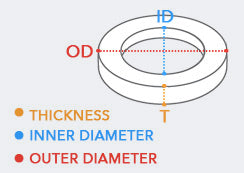Neodymium ring
Super powerful - way exceeded my expectations
Product code: 23005


 Earn 12 points for this product with AMF Magnetics Perks
Earn 12 points for this product with AMF Magnetics Perks
Prices are GST Incl.
Request a Quote for Bulk OrdersAustralia's Leading Supplier
Shipping Worldwide*
30 Day Returns
Same Day Dispatch*

This rare earth ring magnet has an outside diameter of 25mm, an inside diameter of 13mm and a thickness of 8mm. It has a pull force of 10.6 kilograms. It is identified by the AMF Magnetics part number 23005.
Solar systems designed for domestic use in remote locations use these neodymium ring magnets 25mm x 13mm x 8mm to simplify the units operation. Due to the prohibitive cost of establishing and maintaining an electrical distribution network to service often small or tiny far flung populations, small durable solar powered electrical generation systems have a vital, life affirming role to play in communities with little or no access to electricity.
The solar units, like these ring magnets, must be reliable and durable and yet simple to install and operate. The scarcities of skilled technicians or electricians demand a more durable solar unit than is necessary in larger, more sophisticated models suitable for urban or regional areas with simpler access to skilled tradespeople.
Magnets of all kinds are able to play a variety of roles in the installation and operation of solar technology. Ring magnets threaded onto a spool or rod or fixed in place with screws or bolts, can help regulate internal moving parts with predictable pull and push force, even at very high temperatures. Magnets have well-known relations to many different types of materials reducing the opportunity for material incompatibility and increasing the systems longevity.
On the underside, ring magnets can function with the feet or anchors of the unit, a magnetic clamp or permanent grab onto a roof or platform without breaking its surface like screws or bolts with possible water ingress. A magnetic clamp method for anchoring the unit makes the unit much simpler to move, without the penalty of having breached the material of the roof or platform necessitating repair. In cyclone prone regions, release at a pre-determined pull force can be very useful. Failing that, most would rather the solar panel ended up in the lagoon rather than the dwellings roof.
Magnets, for the designers of these systems, constitute a well-established technology with a long history of engagement with electrical and electronics systems. For charging of mobile phones, charging batteries for lighting systems and refrigeration and hot water systems, magnets provide well-established, low cost options in a variety of roles. Solar systems are capable of producing effective and reliable and a cheap source of electricity generation. Small communities that benefit from solar systems enjoy a life affirming resource with the help of the magic of magnets.
No FAQ available

This rare earth ring magnet has an outside diameter of 25mm, an inside diameter of 13mm and a thickness of 8mm. It has a pull force of 10.6 kilograms. It is identified by the AMF Magnetics part number 23005.
Solar systems designed for domestic use in remote locations use these neodymium ring magnets 25mm x 13mm x 8mm to simplify the units operation. Due to the prohibitive cost of establishing and maintaining an electrical distribution network to service often small or tiny far flung populations, small durable solar powered electrical generation systems have a vital, life affirming role to play in communities with little or no access to electricity.
The solar units, like these ring magnets, must be reliable and durable and yet simple to install and operate. The scarcities of skilled technicians or electricians demand a more durable solar unit than is necessary in larger, more sophisticated models suitable for urban or regional areas with simpler access to skilled tradespeople.
Magnets of all kinds are able to play a variety of roles in the installation and operation of solar technology. Ring magnets threaded onto a spool or rod or fixed in place with screws or bolts, can help regulate internal moving parts with predictable pull and push force, even at very high temperatures. Magnets have well-known relations to many different types of materials reducing the opportunity for material incompatibility and increasing the systems longevity.
On the underside, ring magnets can function with the feet or anchors of the unit, a magnetic clamp or permanent grab onto a roof or platform without breaking its surface like screws or bolts with possible water ingress. A magnetic clamp method for anchoring the unit makes the unit much simpler to move, without the penalty of having breached the material of the roof or platform necessitating repair. In cyclone prone regions, release at a pre-determined pull force can be very useful. Failing that, most would rather the solar panel ended up in the lagoon rather than the dwellings roof.
Magnets, for the designers of these systems, constitute a well-established technology with a long history of engagement with electrical and electronics systems. For charging of mobile phones, charging batteries for lighting systems and refrigeration and hot water systems, magnets provide well-established, low cost options in a variety of roles. Solar systems are capable of producing effective and reliable and a cheap source of electricity generation. Small communities that benefit from solar systems enjoy a life affirming resource with the help of the magic of magnets.
No FAQ available

The Pull Force listed for each magnet is based on lifting 10mm thick steel from a horizontal surface. Magnets on a vertical surface (of 10mm thick steel) are generally able to hold around only 30% of the pull force listed in the product description. This is due to the effects of gravity and the lack of friction between the surface and the shiny magnet. Read More